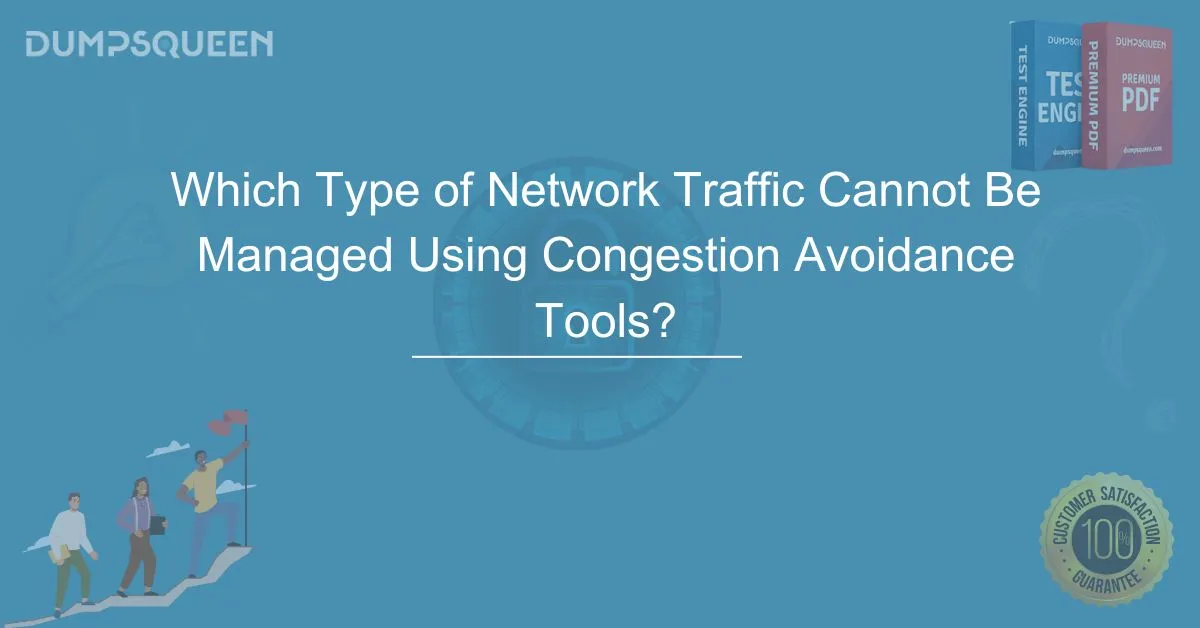Introduction
In modern networking, congestion avoidance tools play a crucial role in managing data traffic efficiently, preventing packet loss, and maintaining optimal network performance. However, not all types of network traffic can be effectively managed using these tools. Some forms of traffic demand special handling due to their real-time nature, critical importance, or protocol limitations. This blog explores the type of network traffic that cannot be managed using congestion avoidance tools, the reasons behind this limitation, and the potential solutions to ensure seamless network operations.
Understanding Congestion Avoidance Tools
What Are Congestion Avoidance Tools?
Congestion avoidance tools are network mechanisms designed to proactively manage traffic before congestion becomes severe. These tools include:
-
Random Early Detection (RED) – Drops packets probabilistically to control congestion.
-
Weighted Random Early Detection (WRED) – Provides preferential treatment to certain types of traffic while avoiding congestion.
-
Explicit Congestion Notification (ECN) – Marks packets instead of dropping them to signal congestion.
-
Traffic Shaping and Policing – Regulates the rate at which packets are sent to prevent congestion.
These mechanisms are effective for most types of network traffic, but they have limitations in handling specific traffic types.
Which Type of Network Traffic Cannot Be Managed Using Congestion Avoidance Tools?
1. Real-Time Traffic (VoIP and Video Streaming)
Voice over IP (VoIP) and video streaming traffic require low latency and minimal jitter. These applications demand real-time delivery, meaning that any delay caused by congestion avoidance mechanisms can lead to poor quality calls or buffering issues. Since these tools often drop packets or introduce slight delays, they are not effective in managing real-time traffic efficiently.
2. Mission-Critical Traffic
Mission-critical applications, such as emergency response systems, financial transactions, and medical data transmissions, cannot tolerate any form of delay or packet loss. These applications require dedicated bandwidth and priority treatment, making congestion avoidance tools unsuitable as they typically rely on probabilistic packet dropping.
3. Non-TCP Traffic (UDP-Based Applications)
Congestion avoidance mechanisms are primarily designed for TCP traffic, which has built-in congestion control mechanisms. However, UDP-based applications, such as DNS queries, streaming media, and gaming, do not have similar congestion control. Since UDP does not retransmit lost packets like TCP, dropping packets due to congestion avoidance can severely impact performance.
4. Multicast and Broadcast Traffic
Multicast and broadcast traffic, used in applications such as IPTV, network discovery protocols, and live conferencing, cannot be easily managed with congestion avoidance tools. These traffic types involve multiple recipients, making it challenging to apply traditional congestion control techniques effectively.
5. Network Control Traffic
Network control traffic, such as routing protocol updates (e.g., OSPF, BGP), system synchronization messages, and network management protocols (e.g., SNMP), is essential for maintaining network stability. These packets must always be delivered promptly and reliably, making congestion avoidance tools ineffective for managing them.
Why Congestion Avoidance Tools Fail for These Traffic Types
The main reasons congestion avoidance tools cannot effectively manage these types of traffic include:
-
Packet Dropping Sensitivity: Real-time and mission-critical applications cannot tolerate packet drops.
-
Latency Sensitivity: Introducing delay to manage congestion degrades the performance of real-time communications.
-
Protocol Limitations: UDP and multicast-based applications do not respond to congestion control like TCP does.
-
High Priority Requirement: Certain traffic types require guaranteed delivery rather than probabilistic management.
Alternative Solutions for Managing Uncontrollable Traffic
Since congestion avoidance tools are ineffective for certain traffic types, alternative methods are required:
1. Quality of Service (QoS)
QoS mechanisms prioritize critical traffic over less important data, ensuring smooth delivery of real-time and mission-critical applications. Techniques include:
-
Traffic Prioritization – Assigning high priority to VoIP, video, and network control traffic.
-
Bandwidth Allocation – Reserving dedicated bandwidth for essential applications.
-
Packet Scheduling – Using methods like Weighted Fair Queuing (WFQ) to manage delays effectively.
2. Traffic Engineering
Using MPLS (Multiprotocol Label Switching) and SD-WAN (Software-Defined Wide Area Network) can help route traffic dynamically to avoid congestion hotspots.
3. Dedicated Network Paths
Organizations dealing with critical applications can establish dedicated network links or private connections, such as leased lines, to avoid congestion altogether.
4. Edge Computing and Caching
Reducing congestion at the core network by processing data closer to users through edge computing and caching popular content can alleviate the need for congestion management.
Conclusion
While congestion avoidance tools are valuable in managing typical network traffic, they fall short when handling real-time, mission-critical, UDP-based, multicast, and network control traffic. These types of traffic require specialized handling, such as QoS, traffic engineering, and dedicated network paths. Understanding these limitations and implementing suitable solutions ensures optimal network performance and reliability, particularly for businesses and applications reliant on real-time data exchange.
Free Sample Questions
1. Which type of traffic is least likely to be managed effectively using congestion avoidance tools?
A) Email traffic
B) VoIP calls
C) File downloads
D) Web browsing
Answer: B) VoIP calls
2. Why do congestion avoidance tools struggle with UDP-based applications?
A) UDP has built-in congestion control
B) UDP does not retransmit lost packets
C) UDP is slower than TCP
D) UDP traffic is always encrypted
Answer: B) UDP does not retransmit lost packets
3. What is the primary reason mission-critical applications cannot rely on congestion avoidance mechanisms?
A) They require high bandwidth
B) They cannot tolerate delays or packet loss
C) They are not widely used
D) They are only used in private networks
Answer: B) They cannot tolerate delays or packet loss



